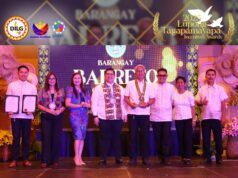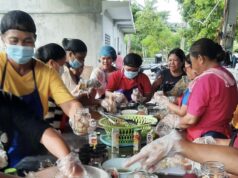SUBIC BAY FREEPORT — Subic-based shipbuilder Hanjin Heavy Industries and Construction-Philippines, Inc. (HHIC-Phil) bagged another huge ship construction project, as its reputation for employing skilled and hard-working Filipinos grew with each finished vessel.
According to Hanjin officials, the firm has signed a contract with Hsin Chien Marine Co., Ltd., a Taiwanese shipping company, for the construction of two 180,000-ton Cape-size bulk carrier vessels due for staggered delivery starting September 2011.
Hanjin landed the new contract shortly after unveiling last month MT Leyla K, the first oil tanker to be made in Subic.
Subic Bay Metropolitan Authority (SBMA) administrator Armand Arreza said the HHIC-Phil, which is now the largest shipbuilder in the Philippines and the fourth biggest in the world, won the new contract because of the well-trained workforce, state-of-the-art technology, highly efficient shipbuilding processes, and high quality of workmanship, which made possible the establishment of a cost-efficient shipbuilding industry here.
“What many foreign investors like about Subic is the competitive workforce,” Arreza said. “The Philippine labor force is more competitive than those in other Asian countries. And here in Subic Bay, we take pride in our talented and high-quality workers.”
Arreza added that local workers have “high-quality motor and technical skills, are quick learners and hardworking, and they put into practice whatever they learn in trainings.”
As of yearend of 2009, shipbuilding and marine-related businesses employ some 25,186 workers in the Subic Bay Freeport.
About 68 percent, or 17,000, of these are employed by HHIC-Phil and its sub-contractors, seven of which are among the top 10 employers here.
According to Arreza, shipbuilding and marine-related industries in the Subic Bay Freeport is fast catching up with the services sector in terms of the number of hired workers, as they are also labor-intensive activities.
He said the highly-skilled Filipino craftsmen enabled Hanjin to expand its operations and start producing 10,000-TEU and 4,000-TEU container ships, oil tankers and bulk carriers, and later on 260,000-ton Q-Max Class coalbed methane-liquefied natural gas carriers, drill ships, floating production storage and offloading (FPSO), and marine plants.
Filipino workers also maintain Hanjin’s two large dry docks, which are each equipped with two Goliath cranes, its four-kilometer quay wall, and its kilometer-long assembly shop.
After starting operations here in 2006, the firm also opened a P40-million training center in Subic, Zambales. The training facility has three classrooms, 70 welding booths, one pipe-fitting room, four painting rooms and a large working area that could accommodate a maximum of 200 trainees and instructors.
HHIC-Phil also opened another training center at the Subic Bay Gateway Park—the P240-million Hanjin Skills Development Center (HSDC), which can accommodate up to 1,200 trainees per batch to train more skilled workers.
The Subic Freeport training center has eight welding shops, two painting shops, two pipe-fitting shops, two lecture and office rooms, and a dining room, all contained in a 40,600-square meter lot.
Since 2006, HHIC-Phil launched several ships, mainly cargo ships, then proceeded to build two units of Very Large Crude Carrier (VLCC) worth a total of $330 million.
Arreza said the entry of Hanjin in Subic Bay Freeport started the “full realization of the Subic Freeport’s mission to create more jobs and alleviate poverty among Filipinos, especially in the Central Luzon region.”
“With the highly-skilled Filipino workers, complemented by state-of-the-art equipment and technology, more shipping companies are now looking into dealing with Hanjin in Subic,” Arreza added.
According to Hanjin officials, the firm has signed a contract with Hsin Chien Marine Co., Ltd., a Taiwanese shipping company, for the construction of two 180,000-ton Cape-size bulk carrier vessels due for staggered delivery starting September 2011.
Hanjin landed the new contract shortly after unveiling last month MT Leyla K, the first oil tanker to be made in Subic.
Subic Bay Metropolitan Authority (SBMA) administrator Armand Arreza said the HHIC-Phil, which is now the largest shipbuilder in the Philippines and the fourth biggest in the world, won the new contract because of the well-trained workforce, state-of-the-art technology, highly efficient shipbuilding processes, and high quality of workmanship, which made possible the establishment of a cost-efficient shipbuilding industry here.
“What many foreign investors like about Subic is the competitive workforce,” Arreza said. “The Philippine labor force is more competitive than those in other Asian countries. And here in Subic Bay, we take pride in our talented and high-quality workers.”
Arreza added that local workers have “high-quality motor and technical skills, are quick learners and hardworking, and they put into practice whatever they learn in trainings.”
As of yearend of 2009, shipbuilding and marine-related businesses employ some 25,186 workers in the Subic Bay Freeport.
About 68 percent, or 17,000, of these are employed by HHIC-Phil and its sub-contractors, seven of which are among the top 10 employers here.
According to Arreza, shipbuilding and marine-related industries in the Subic Bay Freeport is fast catching up with the services sector in terms of the number of hired workers, as they are also labor-intensive activities.
He said the highly-skilled Filipino craftsmen enabled Hanjin to expand its operations and start producing 10,000-TEU and 4,000-TEU container ships, oil tankers and bulk carriers, and later on 260,000-ton Q-Max Class coalbed methane-liquefied natural gas carriers, drill ships, floating production storage and offloading (FPSO), and marine plants.
Filipino workers also maintain Hanjin’s two large dry docks, which are each equipped with two Goliath cranes, its four-kilometer quay wall, and its kilometer-long assembly shop.
After starting operations here in 2006, the firm also opened a P40-million training center in Subic, Zambales. The training facility has three classrooms, 70 welding booths, one pipe-fitting room, four painting rooms and a large working area that could accommodate a maximum of 200 trainees and instructors.
HHIC-Phil also opened another training center at the Subic Bay Gateway Park—the P240-million Hanjin Skills Development Center (HSDC), which can accommodate up to 1,200 trainees per batch to train more skilled workers.
The Subic Freeport training center has eight welding shops, two painting shops, two pipe-fitting shops, two lecture and office rooms, and a dining room, all contained in a 40,600-square meter lot.
Since 2006, HHIC-Phil launched several ships, mainly cargo ships, then proceeded to build two units of Very Large Crude Carrier (VLCC) worth a total of $330 million.
Arreza said the entry of Hanjin in Subic Bay Freeport started the “full realization of the Subic Freeport’s mission to create more jobs and alleviate poverty among Filipinos, especially in the Central Luzon region.”
“With the highly-skilled Filipino workers, complemented by state-of-the-art equipment and technology, more shipping companies are now looking into dealing with Hanjin in Subic,” Arreza added.




